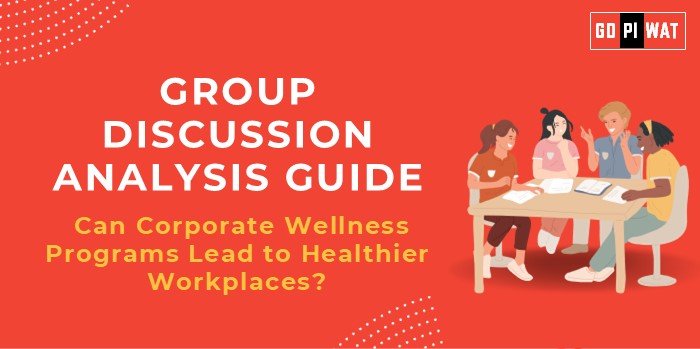📋 Group Discussion Analysis Guide: Can Corporate Wellness Programs Lead to Healthier Workplaces?
🌐 Introduction to the Topic
Opening Context: “In today’s fast-paced corporate environments, employee well-being is no longer a luxury but a necessity. Corporate wellness programs aim to address health challenges, boost productivity, and foster a healthier workplace culture.”
Background: Corporate wellness programs gained traction in the late 20th century with a focus on physical health. Today, they include mental health, financial well-being, and holistic care, reflecting a shift toward comprehensive employee support.
📊 Quick Facts and Key Statistics
– 🌍 Program Adoption Rates: 52% of companies globally have wellness initiatives (SHRM, 2023).
– 💰 ROI: Companies see a $3.27 return for every $1 spent on wellness programs (Harvard Business Review).
– 🧠 Mental Health: 67% of employees say mental health programs significantly improve job satisfaction (Deloitte, 2023).
🤝 Stakeholders and Their Roles
- 👩💼 Employers: Develop and fund wellness programs to enhance workforce productivity and retention.
- 👥 Employees: Participate and provide feedback to improve program efficacy.
- 🏥 Healthcare Providers: Offer services like health screenings, therapy, and fitness consultations.
- ⚖️ Government Bodies: Enforce workplace health regulations and promote mental health awareness.
- 💡 Technology Firms: Deliver digital health solutions like apps for fitness tracking and telemedicine.
🏆 Achievements and Challenges
✨ Achievements
- 📈 Increased Productivity: Organizations with wellness programs report a 25% reduction in absenteeism (WHO).
- 🔄 Employee Retention: Programs reduce turnover by 35% in companies with high adoption.
- 💵 Cost Reduction: Wellness initiatives lead to lower healthcare costs by 15% annually.
⚠️ Challenges
- 📉 Engagement Issues: Only 24% of employees actively participate in wellness programs (Gallup).
- 🌍 Program Accessibility: Remote workers and global teams may face barriers to consistent participation.
- 📊 Evaluation Metrics: Many companies struggle to quantify wellness program ROI.
🌍 Global Comparisons
- 🇺🇸 USA: Pioneers in comprehensive wellness programs like Google’s free gyms and healthcare facilities.
- 🇯🇵 Japan: Emphasis on mental health due to high workplace stress (“karoshi” or death by overwork).
💡 Case Study
🇮🇳 Tata Consultancy Services (India): Employee health programs reduced sick days by 18%, emphasizing fitness and stress management.
💬 Structured Arguments for Discussion
Supporting Stance: “Corporate wellness programs reduce absenteeism, increase productivity, and improve employee retention.”
Opposing Stance: “Such programs often fail due to low participation rates and unclear metrics for success.”
Balanced Perspective: “While corporate wellness programs show potential, their success depends on design, accessibility, and consistent evaluation.”
📚 Effective Discussion Approaches
- 💡 Opening Approaches:
- 📊 “A $300 billion annual productivity loss due to workplace stress underscores the need for wellness programs.”
- 🌍 “While Japan tackles ‘karoshi,’ US firms invest billions in mental health solutions—where does India stand?”
- 📈 “TCS cut sick leaves by 18%, proving wellness initiatives’ measurable impact.”
- 🤝 Counter-Argument Handling:
- ✅ “Low participation? Digital solutions like gamification can drive engagement.”
- 🌟 “Highlight successful programs like Microsoft’s Employee Wellness Challenge.”
🔍 Strategic Analysis of Strengths and Weaknesses
– ⚠️ Weaknesses: Participation gaps, ROI measurement challenges.
– 🌟 Opportunities: Integration with AI, telemedicine.
– 🚧 Threats: Budget constraints, employee skepticism.
📈 Connecting with B-School Applications
- 💡 Real-World Applications: HR strategies, project planning for employee welfare, ROI assessments.
- ❓ Sample Questions:
- 💬 “How do wellness programs impact financial metrics like profitability?”
- 📊 “What role does AI play in enhancing workplace wellness?”
- 📖 Insights for Students: Wellness programs offer avenues for research in HR, AI solutions, and policy development.


